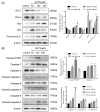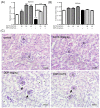Diallyl Trisulfide Inhibits Growth of NCI-H460 in Vitro and in Vivo, and Ameliorates Cisplatin-Induced Oxidative Injury in the Treatment of Lung Carcinoma in Xenograft Mice
- PMID: 28255269
- PMCID: PMC5332871
- DOI: 10.7150/ijbs.16828
Diallyl Trisulfide Inhibits Growth of NCI-H460 in Vitro and in Vivo, and Ameliorates Cisplatin-Induced Oxidative Injury in the Treatment of Lung Carcinoma in Xenograft Mice
Abstract
Diallyl trisulfide (DATS), an organosulfuric component of garlic oil, exhibits potential anticancer and chemopreventive effects. Cisplatin (DDP), a common chemotherapeutic agent, has provided great therapeutic contributions to treating solid tumors, but with serious side effects. Here, we verified the anti-tumor properties of DATS on lung cancer in vitro and in vivo, and evaluated synergistic effects of DATS combined with DDP on the NCI-H460 xenograft model. Significantly decreased cell viabilities, cell cycle G1 arrest, and apoptosis induction were observed in DATS treated NCI-H460 cells (p<0.05). And injection of DATS (30 or 40 mg/kg) to female Balb/c mice significantly inhibited the growth of human NCI-H460 cell tumor xenograft (p<0.001). Moreover, DATS in combination with DDP exhibited enhanced anti-tumor activity via induction of apoptosis. Apoptosis pathways were confirmed by modulation of p53, Bcl-2 family members; induction of active caspase-3/8/9 and activation of JNK- and p38-MAPK pathways. Interestedly, DATS+DDP administration exerted fewer side effects, such as suppressing the weight loss and ameliorating DDP-induced oxidative injury, especially in renal parenchyma. In addition, increased E-cadherin and decreased MMP-9 expression levels were observed in DATS-treated tumor tissues. These studies provide supports that DATS might be a potential candidate for combination with DDP in cancer treatment.
Keywords: Diallyl trisulfide; attenuate side effect.; cisplatin; enhanced effect; lung carcinoma.
Conflict of interest statement
Competing Interests: The authors have declared that no competing interest exists.
Figures







Similar articles
-
Diallyl trisulfide suppresses tumor growth through the attenuation of Nrf2/Akt and activation of p38/JNK and potentiates cisplatin efficacy in gastric cancer treatment.Acta Pharmacol Sin. 2017 Jul;38(7):1048-1058. doi: 10.1038/aps.2016.176. Epub 2017 Mar 27. Acta Pharmacol Sin. 2017. PMID: 28344324 Free PMC article.
-
Garlic-derived organosulfur compound exerts antitumor efficacy via activation of MAPK pathway and modulation of cytokines in SGC-7901 tumor-bearing mice.Int Immunopharmacol. 2017 Jul;48:135-145. doi: 10.1016/j.intimp.2017.05.004. Epub 2017 May 11. Int Immunopharmacol. 2017. PMID: 28501767
-
Diallyl trisulfide suppresses growth of PC-3 human prostate cancer xenograft in vivo in association with Bax and Bak induction.Clin Cancer Res. 2006 Nov 15;12(22):6836-43. doi: 10.1158/1078-0432.CCR-06-1273. Clin Cancer Res. 2006. PMID: 17121905
-
Anticancer effects of diallyl trisulfide derived from garlic.Asia Pac J Clin Nutr. 2008;17 Suppl 1:249-52. Asia Pac J Clin Nutr. 2008. PMID: 18296348 Review.
-
Molecular mechanisms and targets of cancer chemoprevention by garlic-derived bioactive compound diallyl trisulfide.Indian J Exp Biol. 2011 Nov;49(11):805-16. Indian J Exp Biol. 2011. PMID: 22126011 Free PMC article. Review.
Cited by
-
Lipid-Based Nanoparticle Formulation of Diallyl Trisulfide Chemosensitizes the Growth Inhibitory Activity of Doxorubicin in Colorectal Cancer Model: A Novel In Vitro, In Vivo and In Silico Analysis.Molecules. 2022 Mar 28;27(7):2192. doi: 10.3390/molecules27072192. Molecules. 2022. PMID: 35408590 Free PMC article.
-
The Anticancer Effects of the Garlic Organosulfide Diallyl Trisulfide through the Attenuation of B[a]P-Induced Oxidative Stress, AhR Expression, and DNA Damage in Human Premalignant Breast Epithelial (MCF-10AT1) Cells.Int J Mol Sci. 2024 Jan 11;25(2):923. doi: 10.3390/ijms25020923. Int J Mol Sci. 2024. PMID: 38255999 Free PMC article.
-
Recent Research Advances in Multi-Functional Diallyl Trisulfide (DATS): A Comprehensive Review of Characteristics, Metabolism, Pharmacodynamics, Applications, and Drug Delivery Systems.Int J Nanomedicine. 2025 Apr 9;20:4381-4398. doi: 10.2147/IJN.S511417. eCollection 2025. Int J Nanomedicine. 2025. PMID: 40225218 Free PMC article. Review.
-
The Role of Hydrogen Sulfide in the Development and Progression of Lung Cancer.Molecules. 2022 Dec 17;27(24):9005. doi: 10.3390/molecules27249005. Molecules. 2022. PMID: 36558139 Free PMC article. Review.
-
Effects of sulfide and polysulfides transmitted by direct or signal transduction-mediated activation of TRPA1 channels.Br J Pharmacol. 2019 Feb;176(4):628-645. doi: 10.1111/bph.14514. Epub 2018 Nov 26. Br J Pharmacol. 2019. PMID: 30292176 Free PMC article. Review.
References
-
- Katsuki T, Hirata K, Ishikawa H, Matsuura N, Sumi SI, Itoh H. Significance of Garlic and Its Constituents in Cancer and Cardiovascular Disease. Journal of the American Academy of Dermatology. 1997;36:S1–S2. - PubMed
-
- Sun X, Guo T, He J, Zhao M, Yan M, Cui F. et al. Determination of the concentration of diallyl trisulfide in rat whole blood using gas chromatography with electron-capture detection and identification of its major metabolite with gas chromatography mass spectrometry. Yakugaku Zasshi Journal of the Pharmaceutical Society of Japan. 2006;126:521–7. - PubMed
Publication types
MeSH terms
Substances
LinkOut - more resources
Full Text Sources
Other Literature Sources
Medical
Research Materials
Miscellaneous

